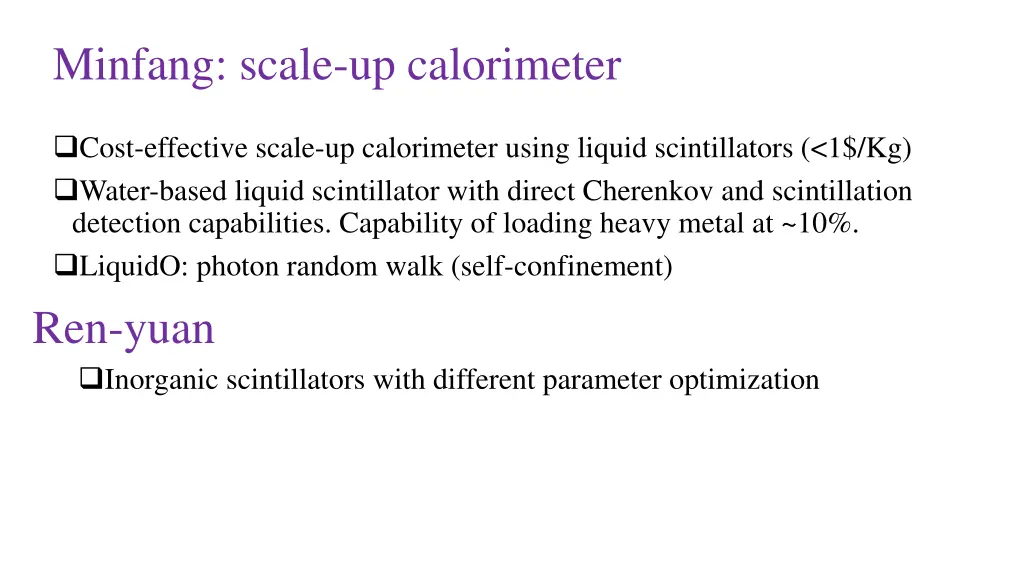
Cutting-Edge Developments in Calorimetry and Detector Technology
Explore innovative research in calorimetry and detector technology, including cost-effective scale-up calorimeters, advanced scintillators, new materials for calorimetry, and front-end electronics needs for high-energy resolution and picosecond timing. Discover the latest advancements in photon detectors, system aspects, and simulation techniques to enhance detector performance for various scientific applications.
Download Presentation

Please find below an Image/Link to download the presentation.
The content on the website is provided AS IS for your information and personal use only. It may not be sold, licensed, or shared on other websites without obtaining consent from the author. If you encounter any issues during the download, it is possible that the publisher has removed the file from their server.
You are allowed to download the files provided on this website for personal or commercial use, subject to the condition that they are used lawfully. All files are the property of their respective owners.
The content on the website is provided AS IS for your information and personal use only. It may not be sold, licensed, or shared on other websites without obtaining consent from the author.
E N D
Presentation Transcript
Minfang: scale-up calorimeter Cost-effective scale-up calorimeter using liquid scintillators (<1$/Kg) Water-based liquid scintillator with direct Cherenkov and scintillation detection capabilities. Capability of loading heavy metal at ~10%. LiquidO: photon random walk (self-confinement) Ren-yuan Inorganic scintillators with different parameter optimization
Bob Hirosky Signal collection/active volume/granularity: direct integration with (in)organic scintillator block fabrication Effectively large area seensors Thin film electronics. OLED displays Dynamic range for ecal: 10MeV-100GeV, readout and sensor integration Fight tyranny of FPGA resource limits: fast, controlled-latency interfaces to CPU/GPU for L1 trigger. Calibration: embedding calibration hardware at cell level Synergies: choose optimization for a specific application, exploiting specific capabilities
R&D drivers: 1.New materials for calorimetry, and how they can be tailored to a specific application (including prospects from nanotechnology); develop industrial partners a. Scale-up material (liquid scintillators) b. Inorganic scintillators Bright, fast, rad hard Ultrafast inorganic (quantum dots may help to break the ps timing barrier) [also medical industry]LuO:Yb can be o Dense-UV transparent, cost-effective heavy inorganic scintillator [water-based liquid scintillator] (HHCAL) c. Maps for cost-effective large scale structures 2. Wavelength shifters to match scintillator (quantum dots, pTP, flavenols) 3. Photon detectors: SiPM
R&D drivers: 1.Front-end electronics needs for high energy resolution: a) High dynamic range [14 bits] 2.Front-end electronics needs for picosecond timing calorimetry: a) Waveform sampling and feature extraction 3.System aspects (mechanical): low mass support & cooling 4.System aspects (electronics): powering scheme & interconnections 5.System aspects (data processing): intelligent calorimeter 6.Concepts from the above lines of investigation that can be adapted to hadron identification (time-of-flight, RICH ) 7.Simulation: speed improvement with respect to GEANT
RaDiCal (Ruchti/Wetzel) Radical: point specific aspects of readout at the front and back
Maps for calorimetry (Brau) Overall detector performance with low-cost material MAPS for tracking and calorimetry are feasible and can be cost effective (standard CMOS foundry, low resistivity, no bump bonding)
Andy White Use of AI
